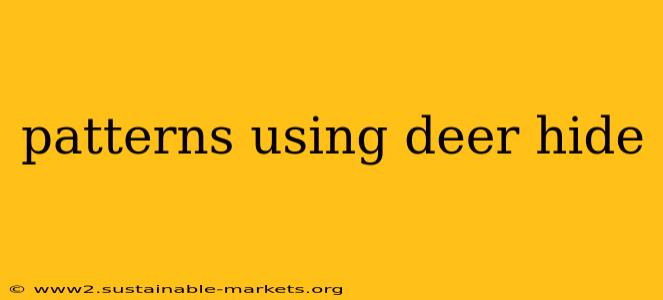Deer hide, a material rich in history and tradition, offers a unique blend of durability and aesthetic appeal. Its supple texture and inherent beauty make it a sought-after choice for a variety of crafting projects. Whether you're a seasoned leatherworker or a curious beginner, understanding how to work with deer hide and explore its pattern possibilities is key to unlocking its full potential. This guide will delve into the unique characteristics of deer hide, explore various patterns suitable for its use, and offer tips for successful crafting.
Understanding Deer Hide: Properties and Considerations
Before diving into patterns, let's understand the material itself. Deer hide, compared to cowhide, is generally thinner and softer, possessing a more delicate, almost suede-like feel. This makes it ideal for certain projects but presents unique challenges. Its thinner nature requires careful handling to prevent tearing or damage.
- Thickness Variations: Deer hide thickness can vary significantly depending on the animal's age and size, as well as the specific area of the hide. This should be considered when choosing a pattern and planning your project.
- Strength and Durability: While not as thick as cowhide, deer hide is surprisingly durable when properly tanned and treated. It's resistant to tearing when handled correctly and can last for many years with proper care.
- Texture and Appearance: The unique texture and subtle variations in color make deer hide a visually appealing material. The natural markings and imperfections add to its character and rustic charm.
Suitable Patterns for Deer Hide: Unleashing Creativity
The delicate nature and unique characteristics of deer hide lend themselves well to specific types of patterns. Here are some ideas:
Simple Geometric Patterns:
These are a great starting point for beginners. Simple shapes like circles, squares, and triangles can be easily cut and stitched, showcasing the natural beauty of the hide without overwhelming it. Consider using these as accents on larger projects or creating small, decorative items like coasters or keychains.
Floral and Nature-Inspired Designs:
The organic nature of deer hide pairs beautifully with floral and nature-inspired patterns. Think delicate leaf shapes, flowing vines, and stylized flowers. These patterns can be used to create intricate embellishments or form the basis for larger projects like wall hangings or clothing accents.
Intricate Intarsia and Leather Carving Patterns:
For more experienced craftspeople, deer hide can be used for intricate intarsia (inlay work) or leather carving projects. However, remember the delicate nature of the material and plan your cuts carefully to avoid damaging the hide. These techniques can produce breathtaking results, adding a layer of artistic depth to the project.
Traditional Native American Designs:
Deer hide has been used for centuries in Native American crafts. Many traditional patterns, often incorporating geometric shapes and symbolic elements, would be beautifully rendered using this material. Researching and respectfully utilizing these designs can add a powerful cultural significance to your work.
Tips for Working with Deer Hide Patterns:
- Pre-treatment: Properly prepare the deer hide before cutting patterns. This might involve softening, stretching, or conditioning the hide to improve its workability and prevent tearing.
- Sharp Tools: Use sharp blades and punches to minimize damage and ensure clean cuts. Dull tools will tear and fray the hide.
- Careful Cutting: Take your time when cutting patterns. Measure twice, cut once, and always work on a stable, clean surface.
- Appropriate Stitching: Select appropriate stitching techniques and thread weight to complement the hide's delicacy. Hand-stitching is often preferred for its precision.
Conclusion: Embracing the Versatility of Deer Hide
Working with deer hide presents a unique and rewarding crafting experience. By understanding its properties and selecting appropriate patterns, you can create stunning and enduring pieces. Whether you choose simple geometric designs or more intricate artistic endeavors, remember to respect the material's delicate nature and celebrate its inherent beauty. The possibilities are endless, limited only by your creativity and imagination.

